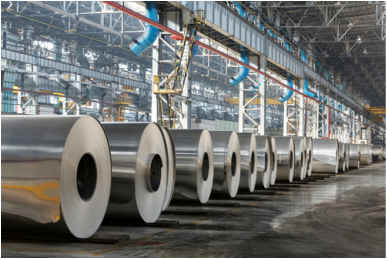One of the primary decisions that must be made when selecting a coil feed system is choosing the correct coil weight capacity. Considering the run time between coil changes in conjunction with the amount of time it takes for a coil change will help you to determine the optimum coil weight for your operation. Generally speaking, maximizing coil weights helps to reduce lost production time due as coil changes can be minimized. However, weight capacity of the existing cranes or lift trucks needs to be considered. In some cases having to also invest in higher capacity material handling equipment to handle larger coils may not be justified by the corresponding increase in efficiency.
Material Thickness
Although width is a major factor in determining coil weight, some other generalizations can be made concerning how quickly a coil will be depleted. Material thickness is another important consideration. For a given coil size, the thinner the material the more linear feet it contains – resulting in longer run times. In general, if you run thin material, short progressions or slow speeds, the run time between coil changes will be longer — in which case smaller coil weights make sense. Equipment for handling smaller coils will cost less and the coils will be a lot easier to handle.
On the other hand, if you use thick material, run long progressions or high speeds, the coils will be consumed at a much faster rate. Larger coil weights and the proper equipment to change coils and thread quickly will be advantageous in this case.
Loading and Threading
The run time between coils must be considered in combination with the amount of time it will take to load and thread a new coil. Light gauge, low strength material is typically more pliable and has less stored energy in the coil. This means that threading is easier, faster, and requires less equipment than will be the case with heavy gauge. So, the effect of larger coils on overall efficiency is not as great even if coil changes must be made more frequently.
With thicker gauge materials or higher strength materials – unless specifically outfitted with particular features — an assumption can be made that threading a new coil will take longer and also be more hazardous. In this case, larger coil weight capacity and the options required to safely and quickly thread thick material will cost much more initially but can be justified by the increased productivity and safety.
Example One:
If an application calls for .250” thick by 24” wide steel with a 36” feed length running at 30 strokes per minute, a 10,000 lb. coil with a 20” I.D. will yield about 163 parts. The run time between coil changes will only be about 5 1/2 minutes. If it takes 10 minutes to load and thread a new coil, then the net yield will be roughly 630 parts per hour if we ignore time for breaks, set up, maintenance and repairs.
If the coil weight is doubled to 20,000 lbs., a coil will yield about 327 parts. The run time between coil changes would increase to nearly 11 minutes and the net yield will increase by 48% — about 935 parts per hour. In this case, the additional cost of equipment to run the bigger coils would be easily justified by the increased productivity.
Example Two:
In another application using .032” thick material at 24” wide with a 20” feed length running at 30 SPM a 10,000 lb. coil would yield 2300 parts, and run for roughly 77 minutes between coil changes. Assuming a time of 5 minutes for coil change, the net yield would be about 1690 parts per hour. If the coil weight is increased to 20,000 lbs. a coil will yield about 4600 parts, and the run time will be 153 minutes.
Including the coil change time the gain would only be about 3% to 1740 parts per hour and it will be difficult to justify the increased cost of equipment to handle the larger coils. In fact, in this case you might want to look at even smaller coils because the cost savings for lighter equipment may more than offset any loss in efficiency.
